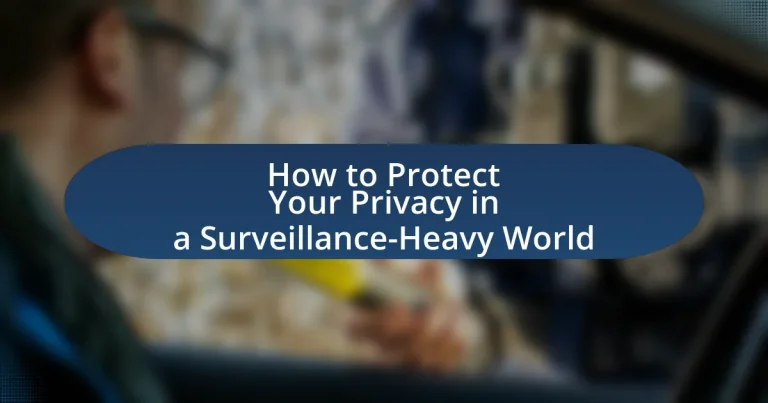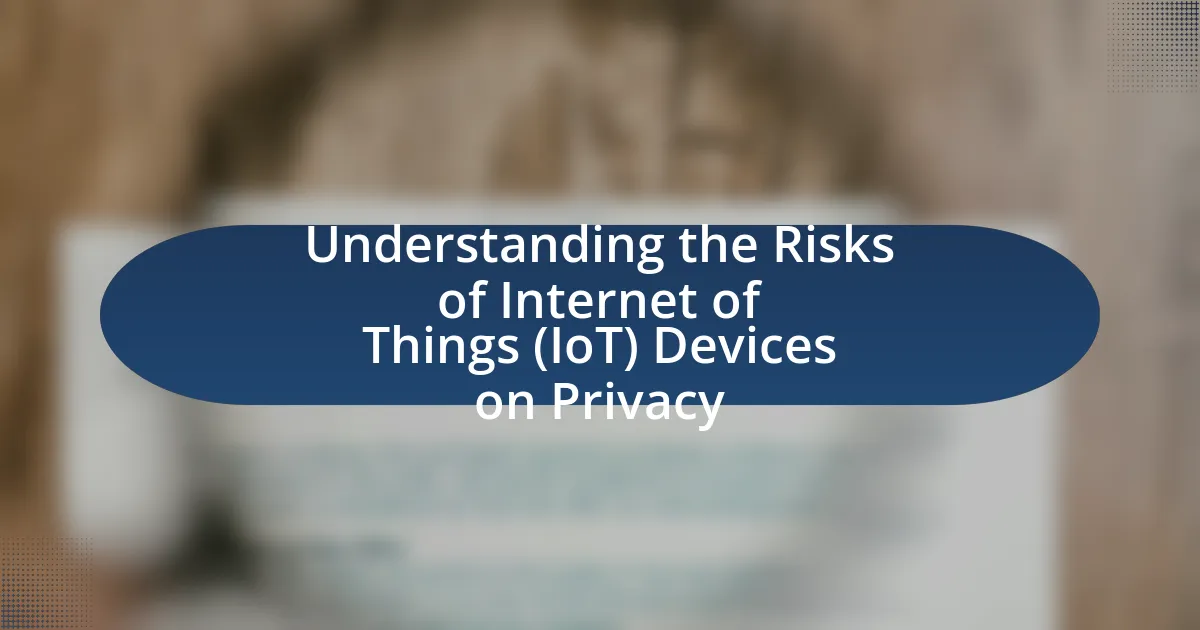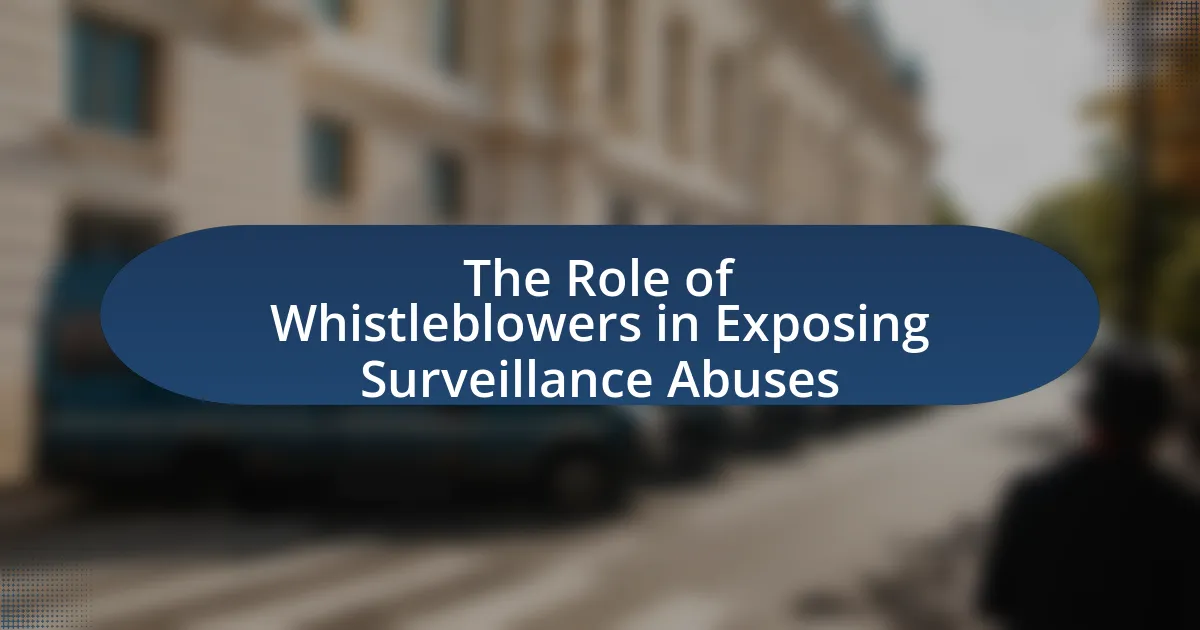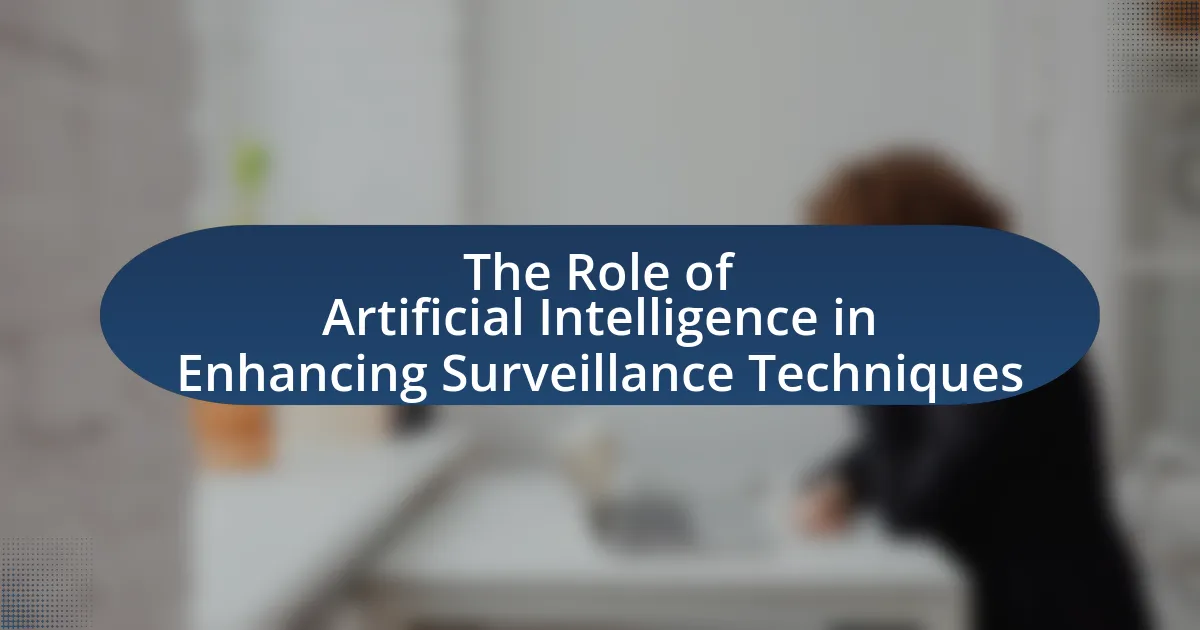The article focuses on the critical issue of protecting personal privacy in a world increasingly dominated by surveillance technologies. It explores the evolution of surveillance methods, the role of various technologies such as CCTV and facial recognition, and how governments and corporations utilize these tools for monitoring and data collection. The article emphasizes the importance of privacy protection, outlines the risks associated with surveillance, and discusses fundamental principles and rights related to personal data. Additionally, it provides practical steps individuals can take to enhance their privacy, including the use of encryption, secure communication tools, and best practices for managing digital footprints.
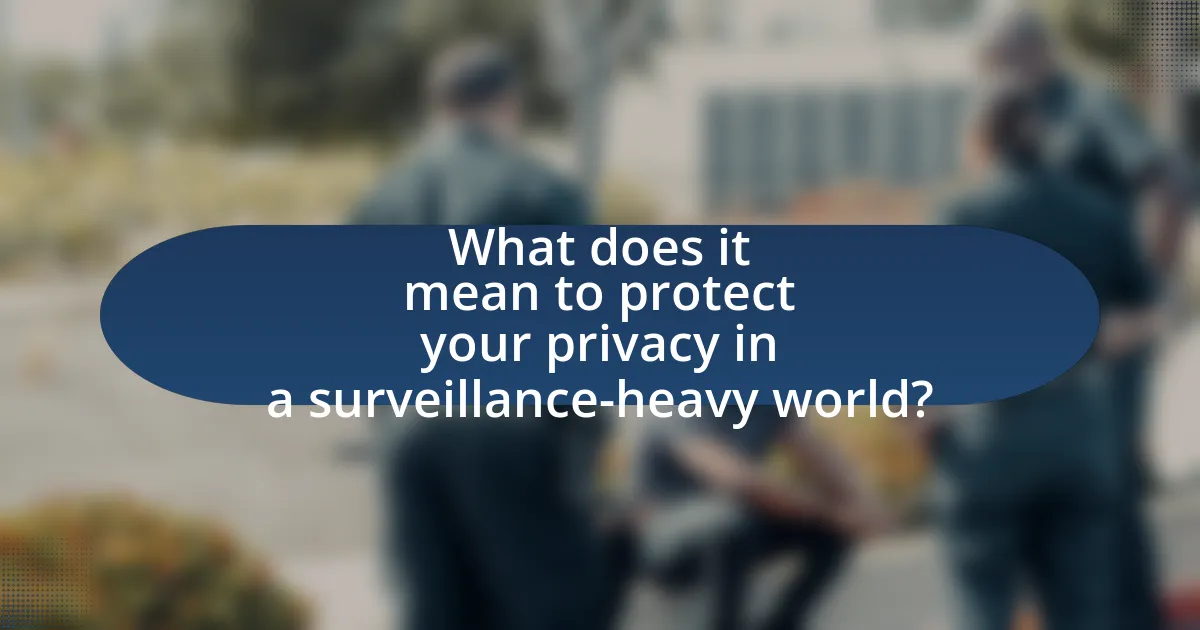
What does it mean to protect your privacy in a surveillance-heavy world?
Protecting your privacy in a surveillance-heavy world means taking proactive measures to safeguard personal information from unauthorized access and monitoring. This involves using tools such as encryption, secure communication channels, and privacy-focused technologies to limit data exposure. For instance, a study by the Electronic Frontier Foundation highlights that using end-to-end encryption can significantly reduce the risk of data interception during online communications. Additionally, individuals should be aware of their digital footprints and actively manage privacy settings on social media and online accounts to minimize the amount of personal data shared publicly.
How has surveillance evolved in modern society?
Surveillance in modern society has evolved from rudimentary methods, such as physical observation and wiretapping, to sophisticated digital monitoring techniques that utilize advanced technologies like artificial intelligence and big data analytics. The introduction of the internet and mobile devices has significantly increased the capacity for surveillance, enabling real-time data collection and analysis on a massive scale. For instance, the proliferation of CCTV cameras, combined with facial recognition technology, allows for continuous monitoring of public spaces, while social media platforms facilitate the tracking of individual behaviors and preferences. According to a 2021 report by the Electronic Frontier Foundation, over 70% of U.S. adults are concerned about government surveillance, highlighting the pervasive nature of modern surveillance practices.
What technologies contribute to increased surveillance?
Technologies that contribute to increased surveillance include closed-circuit television (CCTV) cameras, facial recognition systems, drones, and internet of things (IoT) devices. CCTV cameras are widely deployed in public spaces, providing real-time monitoring and recording capabilities. Facial recognition systems enhance surveillance by identifying individuals in real-time, with studies indicating that these systems can achieve accuracy rates exceeding 90% under optimal conditions. Drones equipped with high-resolution cameras allow for aerial surveillance over large areas, often used by law enforcement and security agencies. IoT devices, such as smart home appliances and wearable technology, collect vast amounts of personal data, which can be accessed and analyzed for surveillance purposes. These technologies collectively create an environment where monitoring and data collection are pervasive, raising significant privacy concerns.
How do governments and corporations utilize surveillance?
Governments and corporations utilize surveillance primarily to monitor behavior, gather data, and enhance security. Governments implement surveillance for national security, crime prevention, and public safety, often using technologies like CCTV, drones, and data collection from digital communications. For instance, the USA PATRIOT Act expanded government surveillance capabilities post-9/11, allowing for increased monitoring of citizens’ communications. Corporations, on the other hand, use surveillance to track consumer behavior, optimize marketing strategies, and protect assets. Companies like Facebook and Google collect vast amounts of user data through their platforms, enabling targeted advertising and user profiling. This dual use of surveillance raises significant privacy concerns, as both entities often operate with minimal transparency regarding data collection and usage practices.
Why is privacy protection important today?
Privacy protection is important today because it safeguards individuals’ personal information from unauthorized access and misuse. In an era where data breaches and surveillance are prevalent, protecting privacy helps maintain autonomy and security. For instance, a 2021 report by the Identity Theft Resource Center revealed that data breaches increased by 68% compared to the previous year, highlighting the urgent need for robust privacy measures. Furthermore, privacy protection fosters trust in digital services, as consumers are more likely to engage with platforms that prioritize their data security.
What are the potential risks of surveillance on personal privacy?
Surveillance poses significant risks to personal privacy, primarily by enabling unauthorized data collection and monitoring of individuals’ activities. This constant observation can lead to a chilling effect on free expression, as individuals may alter their behavior due to fear of being watched. Furthermore, surveillance can result in data breaches, where sensitive personal information is exposed or misused, as evidenced by incidents like the 2017 Equifax breach, which compromised the data of approximately 147 million people. Additionally, the aggregation of surveillance data can facilitate profiling and discrimination, undermining civil liberties and leading to potential abuses of power by authorities.
How can breaches of privacy affect individuals and society?
Breaches of privacy can lead to significant emotional distress and loss of trust for individuals, while society may experience increased surveillance and erosion of civil liberties. Individuals affected by privacy breaches often suffer from anxiety, depression, and a sense of vulnerability, as evidenced by studies showing that 60% of victims of identity theft report emotional distress. On a societal level, widespread privacy violations can normalize surveillance practices, leading to a culture of mistrust and reduced freedom, as highlighted by the 2013 revelations about mass surveillance programs that sparked global debates on privacy rights and government overreach.
What are the fundamental principles of privacy protection?
The fundamental principles of privacy protection include data minimization, purpose limitation, consent, transparency, and security. Data minimization mandates that only necessary personal information is collected, reducing the risk of misuse. Purpose limitation ensures that data is used solely for the specific purposes for which it was collected, preventing unauthorized use. Consent requires that individuals give explicit permission for their data to be processed, reinforcing personal autonomy. Transparency involves clear communication about how data is collected, used, and shared, fostering trust. Lastly, security emphasizes the need for robust measures to protect personal data from unauthorized access and breaches, as highlighted by regulations like the General Data Protection Regulation (GDPR), which enforces these principles to safeguard individual privacy rights.
What rights do individuals have regarding their personal data?
Individuals have specific rights regarding their personal data, including the right to access, rectify, erase, restrict processing, and object to processing of their data. These rights are established under data protection regulations such as the General Data Protection Regulation (GDPR) in the European Union, which empowers individuals to control their personal information. For instance, Article 15 of the GDPR grants individuals the right to obtain confirmation of whether their personal data is being processed and to access that data. Additionally, Article 17 provides the right to request the deletion of personal data under certain conditions, reinforcing the individual’s control over their information.
How can individuals assert their privacy rights effectively?
Individuals can assert their privacy rights effectively by understanding and utilizing legal frameworks such as the General Data Protection Regulation (GDPR) and the California Consumer Privacy Act (CCPA). These regulations empower individuals to access, correct, and delete their personal data held by organizations, thereby enhancing their control over personal information. For instance, under GDPR, individuals have the right to request data portability, allowing them to transfer their data between service providers. Additionally, individuals should regularly review privacy settings on social media and online accounts, ensuring they limit data sharing and enhance security measures. Engaging in advocacy for stronger privacy laws and supporting organizations that promote digital rights can further bolster individual privacy protections.
How can individuals protect their privacy in daily life?
Individuals can protect their privacy in daily life by implementing strong digital security practices, such as using complex passwords and enabling two-factor authentication. Research indicates that 81% of data breaches are due to weak or stolen passwords, highlighting the importance of robust password management. Additionally, individuals should limit the sharing of personal information on social media platforms, as 70% of users have experienced privacy violations due to oversharing. Using privacy-focused tools, such as virtual private networks (VPNs) and encrypted messaging apps, further enhances privacy by masking online activity and securing communications. Regularly reviewing privacy settings on devices and applications also helps individuals maintain control over their personal data.
What tools and technologies can help enhance privacy?
Tools and technologies that can enhance privacy include Virtual Private Networks (VPNs), encryption software, secure messaging apps, and privacy-focused web browsers. VPNs, such as NordVPN and ExpressVPN, mask users’ IP addresses and encrypt internet traffic, making online activities more secure. Encryption software like VeraCrypt protects sensitive files by converting them into unreadable formats without the correct key. Secure messaging apps, such as Signal and WhatsApp, use end-to-end encryption to ensure that only the intended recipients can read the messages. Privacy-focused web browsers like Brave and Firefox with privacy extensions block trackers and ads, further safeguarding user data. These tools collectively contribute to a more private online experience by minimizing data exposure and enhancing user control over personal information.
How do VPNs work to protect online privacy?
VPNs, or Virtual Private Networks, protect online privacy by encrypting internet traffic and masking the user’s IP address. This encryption secures data transmitted between the user’s device and the VPN server, making it difficult for third parties, such as hackers or government agencies, to intercept or monitor online activities. Additionally, by routing internet traffic through a VPN server, the user’s actual IP address is hidden, which helps prevent tracking and profiling by websites and advertisers. According to a study by the Electronic Frontier Foundation, using a VPN can significantly reduce the risk of data exposure and enhance user anonymity online.
What role do encryption and secure communication play in privacy protection?
Encryption and secure communication are essential for privacy protection as they safeguard sensitive information from unauthorized access. By converting data into a coded format, encryption ensures that only authorized parties can read it, thereby preventing eavesdropping and data breaches. For instance, the use of end-to-end encryption in messaging apps like Signal and WhatsApp protects user conversations from interception, as only the sender and recipient can decrypt the messages. This level of security is crucial in a surveillance-heavy world, where data can be easily monitored and exploited. According to a 2021 report by the Electronic Frontier Foundation, strong encryption is a fundamental tool for protecting personal privacy and maintaining the confidentiality of communications in the digital age.
What best practices should individuals follow to safeguard their privacy?
Individuals should follow several best practices to safeguard their privacy, including using strong, unique passwords for different accounts, enabling two-factor authentication, and regularly updating software. Strong passwords reduce the risk of unauthorized access, while two-factor authentication adds an extra layer of security, making it harder for attackers to compromise accounts. Regular software updates patch vulnerabilities that could be exploited by malicious actors. According to a 2021 report by the Cybersecurity & Infrastructure Security Agency, 80% of data breaches involve weak or stolen passwords, highlighting the importance of these practices in protecting personal information.
How can social media settings be adjusted for better privacy?
To adjust social media settings for better privacy, users should navigate to the privacy settings section of their accounts and modify options such as profile visibility, friend requests, and data sharing. For instance, users can set their profiles to private, limiting access to only approved friends, and disable features that allow others to find them through their email or phone number. Additionally, users should review and limit third-party app access to their accounts, ensuring that only trusted applications can access their data. According to a 2021 Pew Research Center study, 81% of Americans feel they have little to no control over the data collected by companies, highlighting the importance of actively managing privacy settings to safeguard personal information.
What steps can be taken to secure personal devices against surveillance?
To secure personal devices against surveillance, users should implement strong passwords, enable two-factor authentication, and regularly update software. Strong passwords reduce the risk of unauthorized access, while two-factor authentication adds an extra layer of security by requiring a second form of verification. Regular software updates patch vulnerabilities that could be exploited by surveillance tools. Additionally, utilizing a virtual private network (VPN) encrypts internet traffic, making it harder for third parties to monitor online activities. Employing security-focused applications, such as encrypted messaging services, further protects communications from interception. These steps collectively enhance device security and privacy in a surveillance-heavy environment.
What common misconceptions exist about privacy in a surveillance-heavy world?
Common misconceptions about privacy in a surveillance-heavy world include the belief that privacy is entirely dead and that individuals have no control over their personal information. Many people assume that because surveillance technologies are pervasive, they cannot protect their privacy at all. However, studies show that individuals can take proactive measures, such as using encryption and privacy-focused tools, to safeguard their data. Additionally, the misconception that only “bad” people need to worry about surveillance overlooks the fact that everyone’s data can be exploited, as evidenced by numerous data breaches affecting millions of users.
Why do some people believe that privacy is no longer achievable?
Some people believe that privacy is no longer achievable due to the pervasive nature of surveillance technologies and data collection practices. The rise of smartphones, social media, and the Internet of Things has led to an environment where personal information is constantly being tracked and analyzed. For instance, a 2021 report by the Pew Research Center found that 81% of Americans feel that the potential risks of companies collecting their data outweigh the benefits. This widespread sentiment reflects a growing concern that individuals have little control over their personal information, leading to the belief that true privacy is unattainable in today’s digital landscape.
How can misinformation about privacy be addressed?
Misinformation about privacy can be addressed through comprehensive education and awareness campaigns that clarify privacy rights and data protection laws. These initiatives should focus on providing accurate information about how personal data is collected, used, and protected, thereby countering false narratives. For instance, the General Data Protection Regulation (GDPR) in Europe outlines specific rights for individuals regarding their personal data, which can serve as a factual basis for educating the public. Additionally, collaboration with technology companies to promote transparency in data practices can further mitigate misinformation by ensuring users understand their privacy settings and options.
What are the future trends in privacy protection?
Future trends in privacy protection include the increased adoption of privacy-enhancing technologies, stricter data protection regulations, and a growing emphasis on user consent and transparency. Privacy-enhancing technologies, such as encryption and decentralized identity solutions, are being developed to give individuals more control over their personal data. Regulations like the General Data Protection Regulation (GDPR) in Europe are setting a precedent for stricter data privacy laws globally, compelling organizations to prioritize data protection. Additionally, there is a rising demand for businesses to implement clear consent mechanisms and transparent data usage policies, reflecting a shift towards user-centric privacy practices. These trends indicate a collective movement towards safeguarding individual privacy in an increasingly surveillance-oriented environment.
How might emerging technologies impact personal privacy?
Emerging technologies significantly impact personal privacy by increasing the capacity for data collection and surveillance. Technologies such as artificial intelligence, the Internet of Things, and facial recognition systems enable organizations and governments to gather vast amounts of personal information without explicit consent. For instance, a study by the Electronic Frontier Foundation highlights that smart devices can track user behavior and preferences, often sharing this data with third parties, which raises concerns about unauthorized access and misuse. Additionally, advancements in data analytics allow for the profiling of individuals based on their online activities, further eroding personal privacy.
What role will legislation play in shaping privacy rights moving forward?
Legislation will play a crucial role in shaping privacy rights moving forward by establishing legal frameworks that protect individuals’ personal information from misuse. As technology evolves, lawmakers are increasingly recognizing the need for comprehensive data protection laws, such as the General Data Protection Regulation (GDPR) in Europe, which has set a precedent for privacy rights globally. These laws not only define how personal data can be collected, processed, and stored but also impose significant penalties for violations, thereby incentivizing organizations to prioritize user privacy. The ongoing discussions around privacy legislation, including potential updates to existing laws and the introduction of new regulations, indicate a growing commitment to safeguarding privacy rights in an era of pervasive surveillance and data collection.
What practical steps can you take today to enhance your privacy?
To enhance your privacy today, start by using a virtual private network (VPN) to encrypt your internet connection. A VPN masks your IP address and secures your online activities from potential surveillance, making it difficult for third parties to track your browsing habits. Additionally, enable two-factor authentication (2FA) on your online accounts to add an extra layer of security, reducing the risk of unauthorized access. Regularly update your software and applications to protect against vulnerabilities that could be exploited by attackers. Finally, review and adjust your privacy settings on social media platforms to limit the amount of personal information shared publicly. These steps collectively strengthen your privacy in a surveillance-heavy world.
